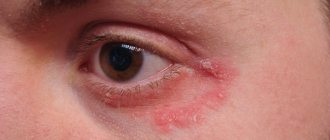What is atheroma
Despite the fact that the pathology looks similar to a skin tumor, it is a sebaceous cyst. The appearance of a lump is associated with a violation of the outflow of glandular secretions and its deposition under the skin layer. The secretion usually accumulates in the duct; it is not removed from the gland and makes its walls stretchable. The greasy contents gradually mix with dead organic substances, cholesterol inclusions, drops of fat, and dead keratinized epidermis. The inside of the neoplasm is lined with flat epithelium.
The structure of skin atheroma can be divided into several elements:
- cavity with contents;
- capsule;
- hole (does not always happen);
- leather;
- subcutaneous fat tissue.
The disease is equally common in men and women. It is a common pathology in skin appendage surgery. Most often, a lump is found on the head due to the presence of a large number of sebaceous glands there.
gormed.su
Having noticed a wen on a child’s body, any parent will worry: is it necessary to urgently contact a specialist? Is your son or daughter going to have surgery? In fact, there are often cases when a lipoma in a young patient does not require treatment at all, but quite often it is accompanied by an infection and ignoring the problem leads to suppuration.
For what reasons does a child develop a lipoma?
Doctors are convinced that the causes in childhood are no different from those in adults. Wen occurs due to blockage of the sebaceous glands. Representatives of traditional medicine claim that slagging in the body is to blame. Another alternative opinion is an imbalance in metabolism provoked by hereditary or acquired factors. All this is true for the child’s body.
Where can you find them?
- A lump on the nose of a baby under three months of age is also called neonatal milia. In this case, experts recommend taking a number of measures to prevent lipomas from scratching and, as a result, their suppuration. It is important to regularly trim your baby's nails and wear baby mittens. If inflammation cannot be avoided, it is enough to treat it with an antiseptic. As a rule, by three months the problem goes away on its own.
- The safest location is the leg. In this case, theoretically, you can do nothing except try to find the cause. It could be a hormonal imbalance in a child’s body, the consequences of which can be much more serious than a cosmetic defect on the skin.
- A large wen on the neck, especially with suppuration, is a good reason to inquire about prices for lipoma removal. The fact is that the formation can penetrate into tissues and lead to circulatory problems. Therefore, you cannot hesitate to consult a specialist.
- If a lipoma appears on the chest, it can cause discomfort when wearing tight clothes. To save the child from discomfort, it is better to remove it.
- On the head, a lipoma can make itself felt in the forehead or on the scalp. If the connective tissue is affected, the formation will be dense, which also indicates its great depth. They can be removed by children over five years of age.
- Sometimes a wen appears on the face and parents mistakenly try to squeeze it out or resort to other folk methods. Such actions can lead to a mark in the form of a scar, therefore, instead of experimenting with the baby’s face, it is best to go to a dermatology clinic or make an appointment with a cosmetologist.
- Sometimes a wen is found on the gum of an infant under one year of age. As a rule, in this case it does not cause discomfort to the baby and disappears on its own with teething.
But if a lipoma is found in the ear, under no circumstances should it be ignored! So be vigilant and don’t let your child’s health take its course.
Causes of atheroma
The specific reason for the appearance of atheroma is the disruption of the sebaceous glands, but a number of predisposing factors lead to this. They are the ones who provoke problems with the separation of sebum, its increased production and blockage of the duct to the outside, which can lead to the appearance of skin atheroma. Factors in the development of the disease include:
- heredity;
- hormonal imbalance (especially in adolescence, when taking hormonal drugs, etc.);
- hyperhidrosis – increased sweating;
- untimely exfoliation of dead skin;
- high viscosity of sebum (individual feature);
- problems with excretory function;
- increased skin contamination;
- narrowness of the gland ducts;
- insufficient hygiene;
- chronic skin trauma;
- negative impact of the environment;
- the use of antiperspirants, which narrow the ducts and clog the gland.
Symptoms and localization
It is not difficult to recognize atheroma by visual examination; additional diagnostics, as a rule, are not required. It looks like a neoplasm located under the skin and comes in various sizes - from a button to a chicken egg. When palpated, the lump is dense, covered with skin, since it is fixed in the area of the gland and does not move freely during palpation. A black dot can be found on the surface - this is a clogged duct of the sebaceous gland. When pressed, fat masses come out.
When palpated, the neoplasm is dense and painless if there is no inflammatory process. Sometimes, in places where visibility is difficult, patients cannot even assume the presence of pathology. When the cyst is small, it does not cause discomfort, and its enlargement occurs quite slowly. For tumors 3–4 cm in diameter, the neoplasm causes discomfort and is a significant cosmetic defect. If we talk about the face, where the skin is thin, patients prefer to remove even small tumors up to 1 cm in diameter, since the lump becomes noticeable.
Atheroma is located in places where sebaceous glands accumulate, actively secreting secretions. Most often, a tumor appears in the head area, growing to large lumps. Skin atheromas are also diagnosed on the back between the shoulder blades, in the neck, on the face, near the tailbone and even on the genitals. They can become encysted with connective tissue, remaining the same painless bumps for a long time.
Symptoms of skin atheroma become more obvious if it suppurates. This usually happens with long-existing large tumors. Typical signs of an inflamed cyst:
- pain at the site of the tumor;
- redness and local hyperthermia;
- subcutaneous abscess;
- swelling of the skin;
- increased body temperature;
- involvement of surrounding structures, such as lymph nodes, in the inflammatory process.
Atheroma during inflammation can open on its own, especially if there was a blocked duct. Purulent discharge and the contents of the gland are released through it. It is better to remove the cyst in a timely manner so as not to worsen the situation. The transformation of pathology into a malignant neoplasm occurs extremely rarely.
Who treats atheroma of the ENT organs
If atheroma appears on the ears, then you should seek help from an ENT doctor
. This specialist specializes in the diagnosis and treatment of diseases of the ear, nose and throat. The study of these organs is united within the framework of the science of otorhinolaryngology. You should contact an ENT doctor if you or your family are concerned about diseases of the upper respiratory tract, runny nose, tumors in the ear area, pain when swallowing and breathing, as well as enlarged parotid lymph nodes. All these symptoms are known to many other doctors, but only an experienced otolaryngologist can prescribe the most effective treatment for you. Timely detection and treatment of diseases of the ENT organs will save you from complications that can spread to other organs.
Treatment
Treatment of skin atheroma is not required if it is small in size and not inflamed. In this case, it is enough to observe the neoplasm. As the size of the tumor increases, if it causes discomfort and is a cosmetic defect, it is removed surgically. Surgery is performed under local anesthesia. There is no conservative treatment for the disease.
The intervention is performed in a clinic and does not require hospitalization if the skin atheroma is small and located in a place convenient for the intervention. The tumor is excised along with the capsule, as this gives a better effect and reduces the risk of relapse in the same place. An uncomplicated tumor is operated on in one of the following ways:
- an incision is made at the site of the neoplasm in its center, the contents are removed, and then the capsule is excised;
- an incision is made along the edge, the cyst is moved along with the intact capsule and removed with a surgical spoon;
- enucleation using two incisions and jaws, which remove the neoplasm along with the capsule.
The latter method of surgical intervention is the most effective. After removal, self-absorbing internal sutures and atraumatic thread sutures are applied, which must be removed after a week.
Possible complications
There are a number of consequences of atheroma:
- Risk of developing into phlegmon with an extensive abscess.
- Risk of relapse if opened independently.
- Risk of formation of suppuration and inflammation.
- The risk of postoperative scars that arise as a result of surgical removal of large atheroma.
- Inflammation of the scars may occur if the atheroma is removed in the clinic.
- As a result of incorrect diagnosis, a relapse may occur.
It is also worth noting that atheroma is a very rare disease; according to statistics, only 7-10% of the world's population gets sick with it. Atheroma is a benign neoplasm that never becomes malignant.
Prevention
There are no effective methods of prevention. If there is increased secretion of the sebaceous glands, atheromas may appear in places near removed bumps or in new locations. As a preventative measure, you can eat less fatty and high-carbohydrate foods so as not to stimulate the glandular apparatus. Use antiperspirants as little as possible; your skin is oily. Use the right skincare products for your skin type to ensure that your pores are free of sebum.
Treatment of green snot in children
The choice of means to treat green snot in a child depends on the cause of its appearance. If it is caused by too dry air in the room, it is necessary to regularly ventilate it, moisten it, and find time every day for walks in the fresh air. For the treatment of green runny nose in children in the absence of fever and signs of intoxication, drops based on purified sea water are suitable. It can be replaced with regular saline solution. In this case, treatment is aimed at moisturizing the mucosa, which helps restore damaged cells.
With acute respiratory infections, thick green snot in a child and swelling of the mucous membrane cause nasal breathing problems. To eliminate unpleasant symptoms, drops are used that constrict blood vessels. Vasoconstrictors should not be used uncontrolled. If you use them for more than 10 days, the sensitivity of mucosal receptors decreases and dependence on these drugs develops.
Medicines that act on the source of the runny nose – the infection itself – will help remove green snot in children. Sialor with silver ions has an antiseptic and anti-inflammatory effect, suppresses the proliferation of bacteria without disturbing the microflora of the mucous membrane. As an additional therapy, topical preparations that contain extracts of aloe, chamomile, and sage will also be beneficial. They relieve irritation and inflammation, eliminate dryness, and help restore mucosal cells.
When treating green snot in children, regular cleaning of the nasal cavity from mucus is required. When you have a cold, it is important to blow your nose correctly: into each nostril in turn, and not into two at the same time. Blowing your nose into both nostrils at the same time increases the pressure in your sinuses. This contributes to the spread of infection, threatens the development of sinusitis, otitis, as well as injury to the mucous membrane. It is important to teach your child how to properly clear mucus from the nose. The easiest way to do this is in a playful way.











